Biodiversity Loss: Quick Facts
1. Biodiversity refers to the variety of life from the molecular to the ecosystem level. It has to do with the number and variety of species, ecological systems, and the genetic variability they contain. It includes genetic differences within each species - for example, among varieties of crops and breeds of livestock. Genetic materials determine the uniqueness of each individual and each species.
At the broadest level of biodiversity the major varieties of ecosystems are known as biomes, and include tundra, deserts, forests, woodlands, oceans, and grasslands. In each ecosystem, living creatures, including humans, form what is called a community, interacting with one another and with the air, water, and soil around them. It is the unique combination of biodiversity interacting with the rest of the environment that has made our planet capable of supporting human life.
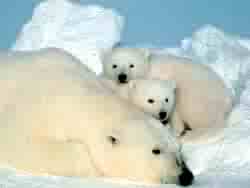
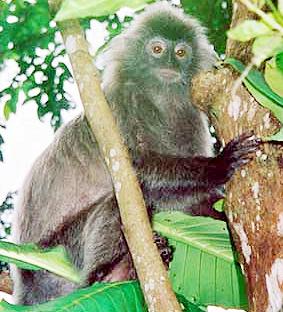
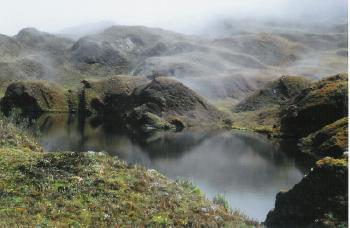
2. Biodiversity plays at least two roles in maintaining natural systems:
- It provides the natural units through which materials and energy flow, giving ecosystems and biomes their functional properties. These types of biodiversity confer stability on ecosystems, and contribute to their effective functioning in mildly fluctuating and predictable conditions. (e.g. salmon returning to their spawing grounds to die there also serves to return important nutrients to the lands of the headwaters)
- Very different kinds of biodiversity are needed to provide resilience when unusual surprises occur – volcanic eruptions, meteor impacts, major fires, disease outbreaks, etc.(e.g. in extreme droughts, some grassland species thrive which otherwise remain dormant in wetter conditions. This diversity maintains the grassland ecosystem under a wide range of climate conditions) These types of biodiversity are less involved with efficient flows of materials and energy, and contribute to ecosystems’ survival and the establishment of a new equilibrium in response to these unpredictable surprises. Upsetting the balance between these different, but still poorly understood types of biodiversity, represents one of the major threats of biodiversity loss.
3. Life is an improbable occurrence. The conditions for life are a rare, if not unique, event in the universe. Both the evolution and maintenance of life depends on an unusual blend of the rare and the common, which allow an organism to survive. One of the most important of these conditions is climate – predictable ranges of temperature and humidity; another is the availability and flow of certain organic and non-organic nutrients.
Without a trace of the rare element phosphorus, for example, protein (based on abundant nitrogen) and carbohydrate polymers would not be possible.1 Without these proteins complex life forms as we know them would not exist. Biodiversity is an expression of how living systems make effective use of these varied elements across the full spectrum of complexity, from genes to biomes. It is biodiversity that allows one life form or another to thrive across most surfaces of the planet, and even survive the most extreme conditions on land, sea and in the atmosphere.
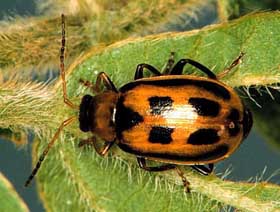

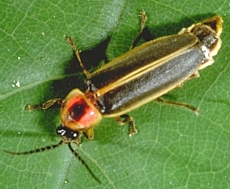

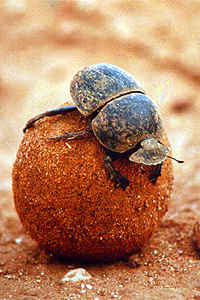


Biodiversity is thus an expression of nature’s problem solving capacities, demonstrating how to survive under varied conditions. A remarkable array of mechanisms has evolved allowing various life forms to flourish. Just a few examples include:
- Insects combine small size (to populate specialized niche subdivions), metamorphism (to allow different life stages to occupy different niches at different times), herbivory (to take advantage of abundant food supplies), and the capacity for relatively rapid mobility (to facilitate dispersal and colonization of empty niches). These characteristics have allowed insects to become one of the most prolific species on the planet, linking plants and the rest of the food chain, and recycling both organic and inorganic materials.
"If one could conclude as to the nature of the Creator from a study of his creation it
would appear that God has a special fondness for stars and beetles." J.B.S.Haldane
- Mutualisms, whereby two or more organisms co-evolve and develop a mutual dependency that benefits all parties involved, are likely one of the most common links in the biosphere. Pollination mutualism among insects, birds and bats and flowering plants is one of the best known examples of rewarding symbioses. Bees, for example, are responsible for pollinating more than 70% of the world’s top 100 crops.2 Bacteria in the human gut make digestion possible.
- Examples of maintaining various types of stability are abundant. Both sharks and bacteria demonstrate constancy (staying essentially unchanged); grasslands through cycles of flood and drought demonstrate resilience (bouncing back to a reference state); ferns indicate persistence (through time); various fire resistance gum trees show resistance (remaining the same in spite of disturbances).
A number of regularities regarding species size, metabolic rates and energy flows can be identified across species.3 But there is still debate about the role of biodiversity in terms of biomass productivity, a major indicator of species success. In some biomes biodiversity is associated with greater productivity (e.g. tropical rain forests), and in other biomes with less (e.g. some extensive and ancient boreal forests, bogs and heathlands are not species rich but highly productive). In still others there seems to be little if any relation. Functional characteristics of the dominant species is sometimes more important than diversity, as with certain grasslands.4 In short, there is much we still do not know about the role of biodiversity in providing ecosystem services.
4. Biodiversity provides a large number of goods and services that sustain our lives. The benefits of biodiversity include:
- Direct economic benefits (e.g. by providing selected crops or animals; or by providing new pharmaceutical compounds)
- Indirect economic benefits (e.g. a wide variety of ecosystem services such as pollination, decomposition of organic material, and nutrient transfers in soil)
- Scientific value, helping us understand how nature works, and by providing models for many devices used by humans, from Velcro to jet engines
- Psychological and aesthetic values by providing items and areas that stimulate all our senses, appeal to our ideals of beauty, and contribute to our sense of well being
- Cultural value by providing items and places which become interwoven with a group’s social and spiritual beliefs and practices
- Options or insurance value, by providing opportunities for survival in changing environments. Biodiversity makes adaptation possible.
The options value is of special significance as human activities alter many aspects of the natural world, including climate. Greater adaptability is going to be required because of these global changes, at a time when adaptability is declining due to biodiversity loss.
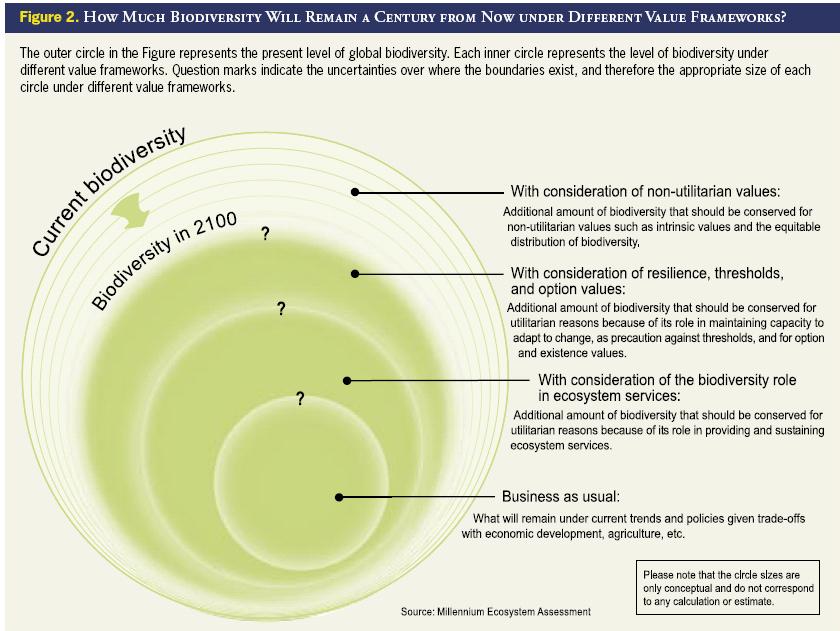
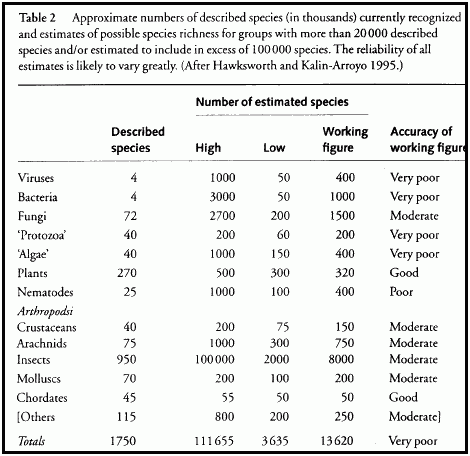 5. There are believed to be between 3 and 100 million species of plants and animals on earth. Estimates vary not only because experts use different methods of classification, but also because of considerable ignorance about just how many types of living things are in the world, and how they are connected. Scientists continue to discover new plant and animal species.
5. There are believed to be between 3 and 100 million species of plants and animals on earth. Estimates vary not only because experts use different methods of classification, but also because of considerable ignorance about just how many types of living things are in the world, and how they are connected. Scientists continue to discover new plant and animal species.
6. The current mass extinction, the only one induced by human activities, is believed to be approaching the largest in the history our planet. It is also occurring faster than any previous mass extinction, measurable in decades rather than in millions of years. We are currently loosing between 100 and 1000 times more species per year than the background extinction rate. On average, one extinction happens somewhere on earth every 20 minutes. If present trends continue, one half of all species on the planet will be extinct in 100 years.
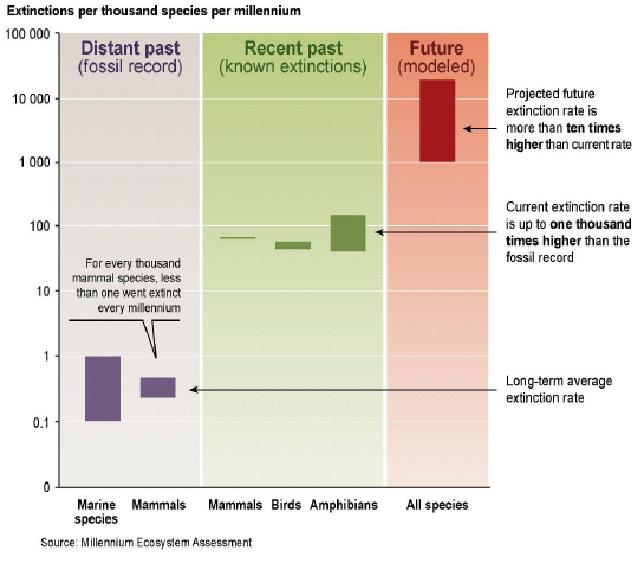
7. The major causes of species loss are urbanization, agriculture, invasive species, pollution, outdoor recreation/tourism, hunting, livestock and ranching activities, mining, industrial/military activity, water diversions, logging, harvesting/collecting, roads, genetic problems, wetland drainage/filling and aquifer depletion, and disease. Many of these causes are interconnected, and almost all can be traced to human economic activity5. The same causes threaten biodiversity from the molecular to the ecosystem level.
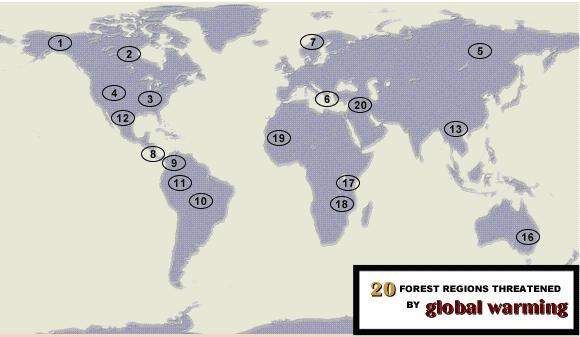 8. Some of the newest threats to biodiversity are coming from human-induced global change processes such as climate change and atmospheric ozone depletion (see Climate Change, and Ozone). Recent studies suggest that by the middle of the century as many as one quarter of the species on the planet today, representing at least one million species, will be jeopardized by changes in climate stability already underway, unless climate change is reversed6.
8. Some of the newest threats to biodiversity are coming from human-induced global change processes such as climate change and atmospheric ozone depletion (see Climate Change, and Ozone). Recent studies suggest that by the middle of the century as many as one quarter of the species on the planet today, representing at least one million species, will be jeopardized by changes in climate stability already underway, unless climate change is reversed6.



 9. In addition to losses through extinctions, major reductions in population size are also a serious threat to biodiversity. Significant reductions in population size reduce the opportunity to reproduce, genetic variability, and ecosystem function. Fewer numbers and reduced genetic variability in turn affect the species’ ability to survive changing environmental conditions. Species reduced to near their minimum viable populations may not ever recover.
9. In addition to losses through extinctions, major reductions in population size are also a serious threat to biodiversity. Significant reductions in population size reduce the opportunity to reproduce, genetic variability, and ecosystem function. Fewer numbers and reduced genetic variability in turn affect the species’ ability to survive changing environmental conditions. Species reduced to near their minimum viable populations may not ever recover.
The American Fisheries Society has recently released the first-ever list of marine fish stocks and species at risk of extinction. It identifies 82 species or populations vulnerable, threatened, or endangered in North American waters, including Atlantic Cod and Halibut. Twenty-two species are at risk globally.
10. Existing species can go extinct rapidly, but new species evolve at a very slow rate. Scientists have calculated from the fossil record that during periods of normal, or background, extinction, species loss occurs at an average of one every four years. It can take millions of years for new vertebrate species to emerge. By what we do or don't do in the next few decades, we will determine the future of evolution in terms of biodiversity composition for at least the next five million years, and in some respects, the next 10-15 million years.
11. Many species have thrived and survived for millions of years due to their abilities to out perform competitors in certain niches (e.g. some crocodile and shark species). Due to the tremendous breadth of the human niche, which expands with technological progress, the scale of the human economy is now expanding to the competitive exclusion of increasing numbers of other species. The current high rate of biodiversity loss is evidence of this human induced competitive exclusion.
12. Some examples of actual species loss include:
- At least 816 species are known to have gone extinct in the wild over the past 500 years due to human activities, although the true number is thought to be far higher.
- Of the 128 recorded species of extinct birds, 103 are known to have become extinct since 1800. Sixteen species of albatross are threatened now compared to just three in 1996 as a direct result of long-line fishing.
- Some 2,000 species of Pacific Island birds (about 15 percent of the world total) have gone extinct since human colonization.
- Roughly 20 of the 297 known mussel and clam species have perished in North America in the past century.
- Many varieties of basic food sources such as wheat, corn, potatoes and apples have gone extinct due to modern farming practices.
- In Indonesia, 1500 local rice varieties have become extinct in the last 15 years
13. In addition to species that have already gone extinct, both the numbers of species at risk, and their level of risk, are increasing. Some examples include:
- The total number of animal species officially listed as endangered has grown from 5,205 species in 1996 to 5,435 species over a six year period. The total number of officially listed endangered animals and plants stands at 11,046.
- Several mammalian species, including most of our closest relatives from the primate family are endangered.
- About 12 percent of the world''s 9,900 bird species are at risk of extinction, and species across the globe are showing increasing signs of distress.
- One plant species in eight worldwide is threatened with extinction
- An estimated 30% of freshwater fish species worldwide may be extinct by the year 2020
- More than 8,000 tree species, 10 percent of the world''s total, are threatened with extinction, and the situation has grown worse over the past five years.
- Alien invasive species (species that invade or are introduced to an area or habitat where they do not naturally occur) are a significant threat, affecting 350 (30 percent) of all threatened birds, and 361 threatened plant species (15 percent).
- Over half of the some 1,200 variety of bamboo are threatened.
14. Some of the ecosystem services lost due to species extinctions include:
- Some 3,000 whole bush land ecosystems in Australia which are disappearing, taking more than 1,500 species with them.
- Overhunting of mountain lions and wolves led to a dramatic increase in the deer population of the Kaibab Plateau in northern Arizona. The deer’s over browsing of shrubs and grasses increased the erosion of soil on the plateau.
- The cutting down of tropical rain forests has resulted in loss of carbon sequestration services, contributing to climatic changes on a regional and global basis.
- Scientists and conservationists worldwide have been raising the alarm in recent years about the impacts of high sea trawlers on the deep ocean habitats, in which millions of species are estimated to live. A recent report stresses that some of these species, such as corals and sponges are slow-growing and long-lived, which make them particularly sensitive to disturbance. It points out that deep sea fish such as Orange Roughy and Patagonian toothfish, which can live for up to 150 years and sometimes reach reproductive maturity only after 30 years of age, are particularly vulnerable to over fishing. Various scientific groups have called on the Conference of Parties on the Convention on Biological Diversity to protect the ocean floor from high seas bottom trawling until effective international management is possible.
- The tundra’s sequestration of methane, a potent greenhouse gas, is diminishing due to increased temperatures in the higher latitudes
- Loss of riparian habitat and wetlands due to a wide range of human activities in many parts of the world has led to a loss of flood control
15. Various governments and international bodies have attempted to address biodiversity loss:
- The Convention on Biological Diversity7 was agreed to in 1992 by the majority of the world’s nations. One of its goals is the preservation of biological diversity.
- CITES (Convention on International Trade in Endangered Species of Wild Fauna and Flora8) has also been endorsed by most countries, seeks to protect some 30,000 species involved in international trade from going extinct. CITES came into force in 1975, and to date not a single species protected by CITES has gone extinct as a result of trade. Various national governments have enacted legislation to protect species within their borders.
- The United Nations treaty known as the Cartagena Protocol on Biosafety9, or the Biosafety Protocol, is the first treaty that formally protects biological diversity from the potential risks posed by genetically modified organisms. Adopted by various governments in 2000, the Biosafety Protocol seeks to protect biological diversity from potential risks that may be posed by living modified organisms (LMOs), also known as genetically modified organisms (GMOs), resulting from modern biotechnology. Numerous international agreements cover a range of specific species or ecosystems such as whales, migratory birds, and wetlands.
16. The many national and international agreements have been of questionable usefulness in protection overall biodiversity to date:
- Despite numerous international agreements and national programs biodiversity loss continues at an increasing rate
- Like most international treaties, the Convention on Biological Diversity is a voluntary agreement and contains no international enforcement agency
- The international notification system under the Biosafety Protocol does not replace national biosafety legislation. Various environmental groups have warned that enacting stricter national legislation on biosafety is still needed.
- The United States has not supported the Biosafety Protocol, and has major differences in its approach to genetically modified life forms than countries that have endorsed the Protocol.
- Recent reports from the International Union for Conservation and Natural Resources indicates that global extinction is worse than previously believed, with dramatic declines in populations of many species, including especially reptiles and primates.
- Since the last assessment in 1996, Critically Endangered primates increased from 13 to 19, and the number of threatened albatross species has increased from 3 to 16 due to birds drowning after accidentally being caught on hooks set by long-line fisheries. Freshwater turtles, heavily exploited for food and medicinal use in Asia, went from 10 to 24 Critically Endangered species in just four years. A species is classed as threatened if it falls in the Critically Endangered, Endangered, or Vulnerable categories.
- The number of Critically Endangered mammals has increased from 169 to 180; Critically Endangered birds increased from 168 to 182
- Twenty four percent (one in four) of mammal species are threatened
- Although the overall percentage of threatened mammals and birds has not greatly changed in four years, the magnitude of risk, shown by movements to the higher risk categories, has increased.
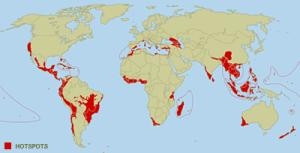 17. Recognizing the importance of biodiversity, and the difficulties inherent in preserving it, some groups have asked the question "which species are most important to save"? Various approaches have emphasized protection for keystone species, endangered species, or what are known as biodiversity hot spots – specific areas with exceptionally high densities of biodiversity. The dangers of attempting to set priorities for preservation efforts is that we are largely ignorant of the values any particular species provides to the web of life or the options value it might provide in a rapidly changing global environment.
17. Recognizing the importance of biodiversity, and the difficulties inherent in preserving it, some groups have asked the question "which species are most important to save"? Various approaches have emphasized protection for keystone species, endangered species, or what are known as biodiversity hot spots – specific areas with exceptionally high densities of biodiversity. The dangers of attempting to set priorities for preservation efforts is that we are largely ignorant of the values any particular species provides to the web of life or the options value it might provide in a rapidly changing global environment.
18. Continued biodiversity loss threatens the web of life upon which humans depend. Global life support systems and biodiversity coevolved. The very atmosphere which makes the earth capable of supporting complex life forms was itself generated by plants and microbial organisms. Biodiversity depends on a complex interplay not only between living things and the natural world, but also amongst living creatures of varying forms and types, in ways we understand only vaguely. Ecosystem services provided by these complex global systems are essential for our quality of life as well as our survival. Biodiversity is essential for ecosystems to thrive and adapt to changing pressures from human activities. The less biodiversity there is and the more its natural composition is disrupted, the more the human enterprise is at risk.
References
1Deevey (1970) in Smil, Vaclav. Energy at the Crossroads: Global Perspectives and Uncertainties. Cambridge, MA: The MIT Press, 2003.
2Nabhan in Smil, Vaclav. Energy at the Crossroads: Global Perspectives and Uncertainties. Cambridge, MA: The MIT Press, 2003: 221.
3Tillman in Smil, Vaclav. Energy at the Crossroads: Global Perspectives and Uncertainties. Cambridge, MA: The MIT Press, 2003: 226.
4Smil, Vaclav. Energy at the Crossroads: Global Perspectives and Uncertainties. Cambridge, MA: The MIT Press, 2003: 199.
5 Czech. B. Shoveling Fuel for a Runaway Train: Errant Economists, Shameful Spenders, and a Plan to Stop Them All, University of California Press, Berkeley, 2000.
Czech, B. Economic growth as the limiting factor for wildlife conservation. Wildlife Society Bulletin, 2000, 28: 4-15.
Czech, B. and P.R. Krausman, Distribution and causation of species endangerment in the United States. Science, 1997, 227: 1116-1117.
6Climate Change Forecast to Extinguish One Million Species http://www.ens-newswire.com/ens/jan2004/2004-01-08-01.asp
7The Convention on Biodiverisity Convention Text. United Nations Environment Programme.
Text of the Convention. CITES Secretariat.
Text of Protocol. United Nations Environment Programme.